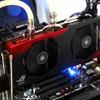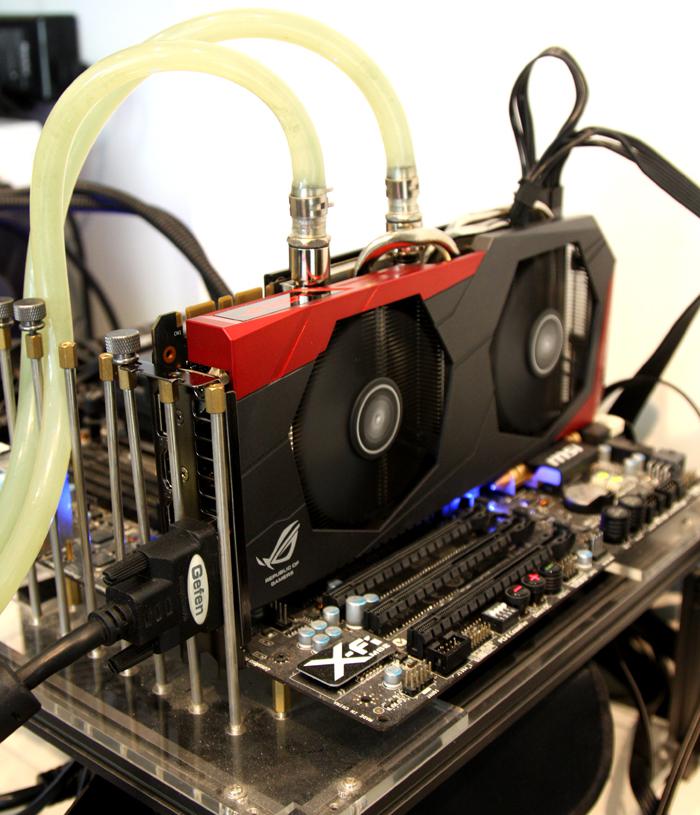Conclusion
Conclusion
You know, I am surprised that ASUS did not clock their card a little higher at default, as the potential is humongous. Even with a little voltage tweak we reached almost 1.60 GHz on the boost frequency thanks to liquid cooling. ASUS has a terrific GTX 980 with the Poseidon at hand. The raw game rendering performance is sweet, the build quality top notch and the DirectCU H2O based cooling offers a very silent product, and heck it can overclock pretty terrifically as well. Combine that with the nice looks, the 6 and 8-pin power headers and that all new cooler, and yeah, we have a winner here. Design wise you either hate or like the looks, nice to see is the included back-plate BTW. You can discuss the functionality of it but it is an option that people truly like these days.
Maxwell GM 204 GPU experience overall
Both the GeForce GTX 970 and 980 leave a very solid impression. One offers good, the other exceptional performance within its range. It’s not heaps faster than the aforementioned 780 series though. So I do not expect Geforce 780 range product owners to upgrade anytime soon. However, if you are in say the GeForce GTX 680 range, then this might be a very nice time to jump on-board with a new card. It is interesting to see that 10 years ago performance per generation nearly doubled. With current release schedules we continuously see 20 to 30% performance increases across the board over the last-gen products. That is still respectable as you need to keep in mind that the GM204 is still on 28nm much like Kepler. Injecting more transistors onto a GPU creates yield issues, heat and high power consumption. The GK110 (GTX Titan / Black), whilst being a true beast of a GPU, is testimony to that. With that in mind Nvidia tried to create a product series that is affordable and plays the most high-end and latest games perfectly fine at an acceptable price level. When you look at it from that point of view the Maxwell release is a successful one. This is probably the maximum that Nvidia should and can do on 28nm in terms of improved performance and power consumption versus price.
Thermals
The reference design of the GTX 970 and 980 are the very same cooling wise. The reference products are set at an offset threshold of 80 degrees C. Once the GPU gets warmer the card will clock down and lower its voltage.
Whether or not you choose Air or Hybrid cooling with a liquid cooling loop, is up to you. Just on air temps are great at roughly 70 Degrees C, but if you purchase a GTX 980 with a liquid cooling block and not liquid cool it I'd call you a pussy! The difference on liquid cooling is ginormous! You get optimal full coverage cooling on the VRM area, the hotspots and the GPU. All temps are in line, VRM at 50~60 Degrees C and the GPU is sitting at 45 Degrees C under full load. Amazing stuff, that said... you do need proper liquid cooling gear. But if we take that reference card at 80 degrees C in mind, and then drop to 45 Degrees C, then yeah, running 35 Degrees lower does amazing things. The cooler looks sturdy and bloke like as well, aesthetically it is a product that is easy on the eyes and will fit any dark and preferably red themed gaming PC quite well.
Cooling versus noise levels
We can’t complain, the Hybrid solution is just very silent and comparable to the normal DirectCU coolers. It is way more cooling compared to what this GPU really needs hence it allows ASUS to pull a trick or two with the Poseidon. Expect sound pressure values in the 39 to maybe 40 dBA range at max under load and warm circumstances. That's measured 75 CM away from the PC. At best you can slightly hear the card while using it heavily. For those that require sheer silence like yours truly, this is the way to go. And in IDLE or normal desktop PC usage, you will not be able to hear this card. You do need to weigh in your own liquid cooling solution here, each setup will vary noise wise. But, that is totally up-to you.
Performance
A nice advantage for the cards is that they now come standard with 4 GB of DDR5 graphics memory, this means gaming sweetness in even the highest resolutions. All games play perfectly at up-to WHQD at 2560x1440, The GeForce GTX 980 is a nice card that certainly offers a nice chunk of performance in those high resolutions, albeit it will fall short here and there if you are at Ultra HD. Overall you can play all the modern and latest games with nice AA levels and excellent image quality, the PC gaming way. GeForce GTX 980 I would recommend with Ultra HD if you can tick off AA, however with upcoming MFAA (pending a driver release) you'll be able to play games quite well with this MSAA equivalent quality AA feature as well. It is a perfect card for gaming up-to 2560x1440.
Tweaking
Without extra voltage tweaking you can expect a 1350~1400 MHz range for the Turbo clock frequency. Depending on how much your board will take and allow, with voltage tweaking you’ll pass the 1500 MHz range. Roughly 1500 MHz on our end works with air-cooling, but it might depend per production batch and also variables like your PC stability, power supply and so on.
Once you throw in liquid cooling then the dynamic changes as you have way more leash in terms of room to play with tweaking wise. We ended up at close to 1.60 GHz on the boost frequency, now that is a crazy clock frequency. Obviously, our overclock is not a guarantee for your results and if you reverse that, your tweaking results could also be better than ours. The memory is clocked standard at 7.0 GHz, you'll fairly easily achieve 7.5 GHz and we even reached close to 8.0 GHz stable. We advise to keep it a notch under 8 Gbps for optimal stability. Roughly 7962 MHz seems to be a sweet-spot for most cards we have tested, they all have Samsung memory ICs. Overall you’ll see a nice gain in extra gaming performance with this tweak.
Final Words
I think the Poseidon is a crazy product when it comes to potential. The default performance is a notch above reference, however once you connect that liquid cooling loop and start tweaking, the sky is the limit. I absolutely love that. Overall in tweaking matters we pushed the card close to 1.60 GHz on the boost frequency, that was the best result with fairly limited voltage tweaking. On water you guys will probably want to stick at 1525 MHz anyway on long term tweaking. Next to all that the card still remains very silent and at cool temperature levels on air, and extremely nice temps on water. The product comes with all the features you'd want, from connectivity for your monitor to the performance cooler, from low noise levels to a nice factory overclock and the sheer aesthetics.
Wrapping it up, the ASUS GeForce GTX 980 Poseidon Platinum edition is yet another great choice, and choices you'll have a-plenty when shopping for a 980. The model as tested today hovers at roughly 600 EURO at the moment of writing, but availability is low, very low. Overall the Poseidon is looking amazing from all viewpoints, it is a beast of a card for Full HD and WHQD PC gaming anno 2014. You flick on all finest image quality settings and get yourself submerged into a quality gaming experience.
The GeForce GTX 980 Poseidon Platinum is an amazing piece of technology. Silky smooth and fluid framerates is what you'll get thanks to the tremendous horsepower at hand combined with low noise levels and temperatures, especially once you start using liquid cooling as an option or your preferred alternative. This product comes recommended by Guru3D.com and we are awarding the product a Top Pick award as it really is that, a top pick.
Related articles
- Nvidia GeForce GTX 970 and 980 reference review
- MSI GeForce GTX 970 Gaming OC review
- Gigabyte GeForce GTX 970 G1 Gaming review
- Gigabyte GeForce GTX 980 G1 Gaming review
- ASUS GeForce GTX 970 Strix review
- Palit GeForce GTX 970 Jetstream review
- GeForce GTX 970 SLI review
- GeForce GTX 980 2 and 3-way SLI review
Recommended Downloads
Sign up to receive a notice when we publish a new article
Or go back to Guru3D's front page


